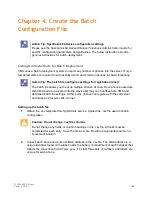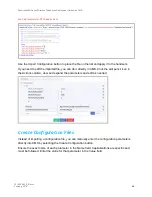
721-0048-000_B.docx
February 2018
68
Chapter 9:
Configure Custom Settings
You may want to customize your installation even further. CMS provides a Custom Settings
page that allows you to create a custom file or import your own .xml files at the Enterprise level.
Custom settings can also be applied at the Device and Group levels from those respective
pages.
When using custom settings aA couple of caveats apply so please be aware:
•
.xml files must be well formed. Use a template from Spectralink software as shown
below for an example.
•
Use an XML editor to create or edit xml or .cfg files.
Foxe
is an editor from First Object that shows a tree view and text view and allows you
to make edits in either. It apparently does not have the field limitations of XML Notepad
so you could use it if you have lengthy certificates. Examples in this document use
Foxe
.
Foxe
is free and available at:
http://www.firstobject.com/dn_editor.htm
Three actions are provided for each custom file:
•
Apply to Enterprise; applies the custom setting file to all handsets at the Enterprise level.
•
Delete: removes the custom settings file from the list.
•
Disassociate: retains the custom settings file on the list but removes it from active use by
devices.
Import Configuration Files
Unless you are an expert with XML, you will find it easiest to create new .xml files by opening an
existing file and saving it as a new name. The templates are designed to make this easy so that
usually only a few values need to be changed to customize the file. Some filenames must be
very specific and you will find precise naming instructions in the configuration sections in Part II.
When you need to refine the .cfg files to suit your own requirements, parameters can be copied
from sample files provided with the downloaded code and pasted into the files you have
developed for this initial deployment. Or you may decide to establish your own feature structure
by locating the parameters you wish to modify in one of the sample files, editing the contents
accordingly and saving it with a file name that conforms to your file structure strategy.








































